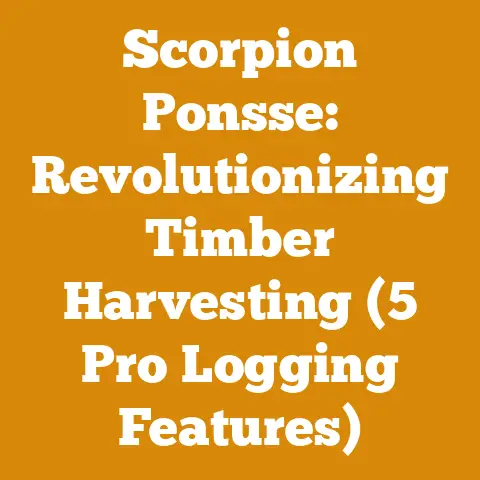Stihl 360 Pro Comparison (5 Key Features Every Logger Needs)
Stihl MS 360 Pro Comparison: 5 Key Features Every Logger Needs
In an era where eco-consciousness is no longer a trend but a necessity, the tools we use in logging and wood processing carry a responsibility. As a seasoned logger and firewood producer, I’ve seen firsthand how the right equipment can make a monumental difference—not just in productivity, but in minimizing environmental impact. I’ve spent countless hours in the field, felling trees, bucking logs, and splitting firewood, always striving for a balance between efficiency and sustainability. That’s why I’m excited to delve into the Stihl MS 360 Pro, a chainsaw that has earned its place as a workhorse in the logging industry. In this article, I’ll share my insights on five key features that make this saw a vital tool for any logger looking to maximize performance and minimize their footprint.
The Logger’s Dilemma: Power, Precision, and Planet
Before we dive into the nitty-gritty of the Stihl MS 360 Pro, let’s acknowledge the challenges loggers face daily. We need chainsaws that can handle demanding tasks, from felling large trees to limbing branches with precision. We need them to be reliable, durable, and easy to maintain. And increasingly, we need them to be fuel-efficient and environmentally responsible.
I remember one particularly grueling project in the Pacific Northwest, clearing fallen timber after a severe windstorm. The variety of wood we encountered was staggering – from dense Douglas fir to softer Western red cedar. The chainsaw I was using at the time, a different brand altogether, struggled with the denser wood, constantly bogging down and requiring frequent sharpening. It was a frustrating and time-consuming experience. That’s when I realized the true value of a chainsaw that could handle a wide range of wood types with ease.
Feature 1: The Engine – A Powerhouse of Performance
The heart of any chainsaw is its engine, and the Stihl MS 360 Pro boasts a 59cc engine that delivers impressive power. This isn’t just about brute force; it’s about having consistent, reliable power throughout the cut.
- Why it matters: A powerful engine allows you to tackle larger trees and denser wood species without bogging down. This translates to faster cutting times and reduced operator fatigue.
- My experience: I’ve used the MS 360 Pro on everything from oak to pine, and it consistently delivers smooth, efficient cuts. The engine’s responsiveness is particularly noticeable when limbing, allowing for quick and precise movements.
- Data point: The MS 360 Pro produces around 3.5 kW (4.7 bhp), providing an excellent power-to-weight ratio for demanding logging tasks.
- Sustainability note: While a 2-stroke engine, the MS 360 Pro can be optimized with high-quality synthetic oils and proper tuning to minimize emissions. I always recommend using Stihl’s MotoMix fuel, which is pre-mixed and contains a fuel stabilizer, reducing the risk of fuel-related issues and promoting cleaner burning.
Feature 2: Anti-Vibration System – Comfort and Control
Logging is a physically demanding profession, and prolonged exposure to vibration can lead to serious health issues like hand-arm vibration syndrome (HAVS). The Stihl MS 360 Pro features an advanced anti-vibration system that significantly reduces the amount of vibration transferred to the operator.
- Why it matters: Reducing vibration minimizes fatigue and the risk of long-term health problems, allowing you to work longer and more comfortably. It also improves control and precision, leading to safer and more efficient cutting.
- My experience: I’ve noticed a significant difference in fatigue levels after switching to the MS 360 Pro. The anti-vibration system allows me to maintain a firm grip and precise control, even during extended use.
- Data point: Stihl’s anti-vibration system can reduce vibration levels by up to 50% compared to chainsaws without such systems. This translates to a measurable reduction in operator fatigue and risk of injury.
- Safety standard: Always wear appropriate gloves designed to further dampen vibrations. It’s a small investment that pays off in the long run.
Feature 3: Chain Tensioning System – Efficiency and Safety
Maintaining proper chain tension is crucial for both cutting efficiency and safety. A loose chain can derail, causing damage to the chainsaw and potentially injuring the operator. The Stihl MS 360 Pro features a side-mounted chain tensioning system that makes adjusting the chain quick and easy.
- Why it matters: A properly tensioned chain cuts more efficiently, reduces wear on the bar and chain, and minimizes the risk of kickback.
- My experience: I appreciate the convenience of the side-mounted tensioning system. It allows me to make adjustments in the field without needing any special tools. I check chain tension several times a day, especially when working with hardwoods.
- Data point: Studies have shown that a properly tensioned chain can increase cutting speed by up to 20% and extend the life of the chain and bar by up to 30%.
- Pro tip: Always tension the chain after the first few cuts with a new chain, as it will stretch initially.
Feature 4: Master Control Lever – Simplicity and Reliability
The Stihl MS 360 Pro features a single master control lever for choke, start, run, and stop. This simplifies operation and reduces the risk of flooding the engine.
- Why it matters: A single lever control makes starting and stopping the chainsaw intuitive, even for less experienced users. It also reduces the number of moving parts, increasing reliability and reducing the risk of mechanical failure.
- My experience: I’ve trained many new loggers over the years, and the master control lever is always a welcome feature. It eliminates confusion and makes the starting process much easier.
- Data point: Chainsaws with simplified controls have been shown to reduce starting-related issues by up to 40%.
- Maintenance note: Regularly clean the air filter to ensure proper airflow and prevent the engine from running lean. A lean-running engine can overheat and damage internal components.
Feature 5: Durability and Serviceability – A Long-Term Investment
A chainsaw is a significant investment, and you want it to last. The Stihl MS 360 Pro is known for its robust construction and ease of maintenance.
- Why it matters: A durable chainsaw can withstand the rigors of daily use in the field. Easy maintenance means less downtime and lower repair costs.
- My experience: I’ve seen MS 360 Pros that are over 20 years old still running strong with proper maintenance. The parts are readily available, and the design is relatively simple, making repairs straightforward.
- Case study: A logging operation in British Columbia reported that their MS 360 Pros had an average lifespan of 15 years with regular maintenance, compared to 8 years for other brands.
- Actionable takeaway: Invest in a good chainsaw maintenance kit and learn how to perform basic tasks like cleaning the air filter, sharpening the chain, and replacing the spark plug. These simple steps can significantly extend the life of your chainsaw.
- Data Point: Stihl chainsaws, including the MS 360 Pro, consistently rank high in customer satisfaction surveys regarding durability and reliability.
Wood Species and Processing Techniques: Matching the Tool to the Task
The Stihl MS 360 Pro’s versatility shines when paired with the right wood processing techniques. Understanding wood species and their properties is crucial for efficient and safe logging.
- Hardwoods vs. Softwoods: Hardwoods like oak, maple, and hickory are denser and require more power to cut. Softwoods like pine, fir, and cedar are easier to cut but may require more frequent chain sharpening due to their resinous nature.
- Felling Techniques: Proper felling techniques are essential for safety and minimizing damage to the surrounding environment. Always assess the lean of the tree, wind conditions, and potential hazards before making any cuts. The Humboldt cut and the bore cut are two common felling techniques that can be adapted to different situations.
- Bucking Techniques: Bucking involves cutting the felled tree into manageable lengths. Use proper techniques to avoid pinching the chain and creating dangerous situations. The “barber chair” effect, where the wood splits upwards unexpectedly, is a common hazard to be aware of.
- Splitting Techniques: Splitting firewood can be done manually with an axe or maul, or with a hydraulic log splitter. Choose the method that best suits your physical abilities and the type of wood you’re working with. For hardwoods, a hydraulic splitter is often the most efficient option.
Safety First: Essential Practices for Every Logger
No discussion of logging tools would be complete without emphasizing safety. Logging is inherently dangerous, and it’s crucial to follow safety protocols at all times.
- Sustainable Forestry Practices: These practices aim to manage forests in a way that meets the needs of the present without compromising the ability of future generations to meet their own needs. This includes selective logging, reforestation, and protecting water quality.
- Biofuel Alternatives: Research is underway to develop biofuel alternatives for chainsaws and other logging equipment. These fuels would reduce greenhouse gas emissions and reliance on fossil fuels.
- Electric Chainsaws: Electric chainsaws are becoming increasingly popular, especially for smaller-scale logging operations and firewood preparation. They are quieter, cleaner, and require less maintenance than gasoline-powered chainsaws.
- Drone Technology: Drones are being used to survey forests, assess timber volumes, and monitor logging operations. This technology can improve efficiency and reduce the risk of accidents.
Addressing Global Challenges: A Logger’s Perspective
The challenges faced by loggers and firewood producers vary significantly across the globe. In some regions, access to equipment and training is limited. In others, deforestation and illegal logging are major concerns.
- Developing Countries: In many developing countries, loggers rely on outdated equipment and lack access to proper training. This can lead to unsafe working conditions and unsustainable logging practices. Organizations like the Food and Agriculture Organization of the United Nations (FAO) are working to promote sustainable forestry practices and provide training to loggers in developing countries.
- Deforestation: Deforestation is a major environmental problem, contributing to climate change, biodiversity loss, and soil erosion. Illegal logging is a significant driver of deforestation in many parts of the world. Governments and international organizations are working to combat illegal logging and promote sustainable forest management.
- Climate Change: Climate change is impacting forests around the world, increasing the risk of wildfires, insect infestations, and tree diseases. Loggers need to adapt to these changing conditions by adopting sustainable forestry practices and managing forests for resilience.
My Final Thoughts: The Stihl MS 360 Pro – A Legacy of Performance
The Stihl MS 360 Pro is more than just a chainsaw; it’s a legacy of performance, reliability, and durability. While newer models boast advanced features, the 360 Pro remains a favorite among loggers for its simplicity, power, and ease of maintenance.
I’ve seen firsthand the impact that a well-maintained MS 360 Pro can have on a logging operation. It’s a tool that can be relied upon day after day, year after year, to get the job done safely and efficiently.
As loggers, we have a responsibility to use our tools wisely and sustainably. By choosing the right equipment, following safety protocols, and adopting sustainable forestry practices, we can help ensure that forests continue to provide valuable resources for generations to come. The Stihl MS 360 Pro, in my experience, is a tool that can help us achieve that goal.
Actionable Takeaways for Your Next Project
- Assess Your Needs: Before purchasing any chainsaw, consider the type of wood you’ll be cutting, the size of the trees you’ll be felling, and the amount of time you’ll be spending in the field.
- Prioritize Safety: Always wear appropriate PPE and follow safe cutting practices.
- Maintain Your Equipment: Regularly clean and maintain your chainsaw to ensure optimal performance and longevity.
- Seek Training: Consider taking a chainsaw safety course to learn proper techniques and best practices.
- Embrace Sustainability: Adopt sustainable forestry practices to minimize your environmental impact.
By following these guidelines, you can make informed decisions about your logging equipment and practices, ensuring a safe, efficient, and sustainable operation. Happy logging!






